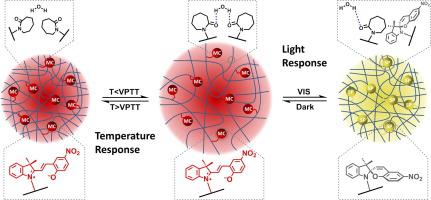Journal of Colloid and Interface Science ( IF 9.4 ) Pub Date : 2020-09-03 , DOI: 10.1016/j.jcis.2020.08.081 Chaolei Hu 1 , Wenjing Xu 1 , Christian Martin Conrads 2 , Jingnan Wu 2 , Andrij Pich 3

|
Hypothesis
Light-responsive microgels are interesting colloidal systems with potential applications in the biotechnology and medicine. However, synthesis of light-responsive microgels with high loading of photoswitchable molecules is still very challenging.
Experiments
Herein we developed a new method to synthesize light and temperature dual-responsive spiropyran-modified poly(N-vinylcaprolactam) microgels. The novel and straightforward microgels synthesis route involved: a) synthesis of poly(N-vinylcaprolactam-co-vinylformamide) copolymers via RAFT polymerization followed by the hydrolysis to obtain primary amine groups, b) attachment of carboxyl-modified spiropyran molecules to polymer chains via coupling, and c) crosslinking of spiropyran-modified polymer chains in W/O miniemulsion to form microgels.
Findings
Via this method, we successfully synthesized poly(N-vinylcaprolactam) microgels containing more than 10 mol% spiropyran. The reversible light responsiveness of the spiropyran-modified copolymers and microgels in aqueous solution, which originates from the spiropyran photoisomerization under irradiation with different wavelengths, was demonstrated by UV–Vis spectroscopy. Spiropyran-modified copolymers demonstrate shift of the lower critical solution temperature (LCST) due to the polarity change of spiropyran molecules under dark, UV and visible light. Surprisingly, dynamic light scattering (DLS) results show that the microgels based on the same copolymers are less affected by UV irradiation. Microgels are swollen in darkness when spiropyran molecules are in the polar, merocyanine form, and collapse after irradiation with visible light, due to the transformation of spiropyran to the relatively nonpolar, closed spirocyclic form. In addition, the spiropyran-modified microgels exhibit reversible temperature responsiveness by presenting a volume phase transition in water from a swollen state to a collapsed state with increasing temperature and the transition temperature decreased compared to the pristine microgels due to the hydrophobicity of spiropyran units.
中文翻译:

通过螺吡喃改性的预聚物的交联得到可见光和温度的双响应微凝胶。
假设
光响应性微凝胶是有趣的胶体系统,在生物技术和医学中具有潜在的应用。然而,具有高负载的光可切换分子的光响应性微凝胶的合成仍然非常具有挑战性。
实验
在这里,我们开发了一种合成光和温度双响应螺吡喃修饰的聚(N-乙烯基己内酰胺)微凝胶的新方法。新颖而直接的微凝胶合成路线包括:a)通过RAFT聚合反应合成聚N-乙烯基己内酰胺-共乙烯基甲酰胺共聚物,然后水解以获得伯胺基团,b)羧基修饰的螺吡喃分子通过偶联,和c)W / O细乳液中螺吡喃改性的聚合物链交联形成微凝胶。
发现
通过这种方法,我们成功合成了poly(N-乙烯基己内酰胺)微凝胶,其中含有超过10 mol%螺吡喃。紫外-可见光谱法证明了螺吡喃改性的共聚物和微凝胶在水溶液中的可逆光响应性,其源自螺吡喃在不同波长下的光异构化。螺吡喃改性的共聚物由于在黑暗,紫外和可见光下螺吡喃分子的极性变化而显示出较低的临界溶液温度(LCST)的变化。出乎意料的是,动态光散射(DLS)结果表明,基于相同共聚物的微凝胶受紫外线辐射的影响较小。当螺吡喃分子呈极性,花青形式时,微凝胶在黑暗中膨胀,并在可见光照射下崩解,由于螺吡喃转变成相对非极性,封闭的螺环形式。另外,螺吡喃修饰的微凝胶通过呈现水的体积相转变而显示出可逆的温度响应性,其中该体积相转变随着温度升高而从溶胀状态变为塌陷状态,并且由于螺吡喃单元的疏水性,与原始微凝胶相比,转变温度降低。











































 京公网安备 11010802027423号
京公网安备 11010802027423号